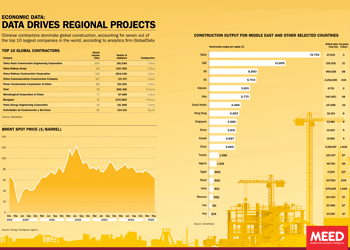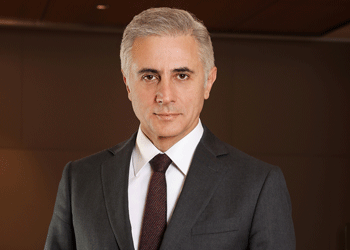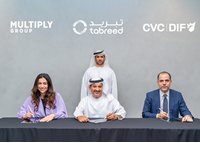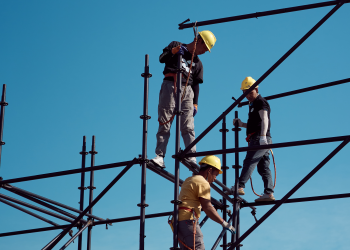Soaring data demand drives boom
29 May 2023

 > This package also includes: Region plans vital big grid connections
> This package also includes: Region plans vital big grid connections
Power links carry economic, climate and political significance
The world’s longest submarine communications cable system reached its first two landing sites in Jeddah and Yanbu in Saudi Arabia in early May.
The 45,000-kilometre 2Africa cable system will arrive at its third landing site in Duba, Saudi Arabia, later this year and its fourth site in Al-Khobar in 2024. 2Africa will take the number of submarine cable system landing sites in Saudi Arabia to 27, with 13 located in the Red Sea port city of Jeddah.
An expansion in submarine cable landing sites supports the kingdom’s ambition – and that of the broader Middle East and North Africa (Mena) region – to become a global digital hub.
The submarine cables enable high-speed, low-latency connectivity between regions and facilitate the transfer of vast amounts of data across national borders. They can help to unlock significant economic potential arising from products and services enabled by information technology (IT) and data connectivity, including e-commerce, machine learning, Big Data and artificial intelligence (AI).

Source: Telegeography
This will be supported by the strategic geographical advantage of Middle East countries to connect the digital traffic and services between Asia, Africa and Europe – a development that is being mirrored by the planned long-distance power interconnectors across the region.
“Subsea cables provide faster and more dependable internet access than older methods such as satellite or microwave communications,” says Ziad Samaha, an executive with UAE-based Khazna Data Centres.
Driving investment
Kamel al-Tawil, managing director for Mena at US-headquartered firm Equinix, also notes that the increased connectivity provided by subsea cables “can help attract more international businesses to the region, driving economic growth and creating new opportunities for the data centre and wider IT industry”.
The largest telecommunications companies and their data subsidiaries have been building data centres to support their operations and clients’ requirements in recent years.
The explosive growth in data and the advent of cloud services – or renting software applications as opposed to buying licences to use them – in addition to general uncertainty about regulations governing data sovereignty in most jurisdictions, have propelled the region into a data centre-building boom.
This began when US-based Amazon Web Services (AWS) established its first availability zone or data centre cluster in Bahrain in 2019. AWS has since built availability zones in the UAE, with further plans to invest $5bn over 15 years to enhance its data infrastructure in the country.
The scale of Saudi Arabia’s ambition to become a digital hub has been met with commitments to build data infrastructure within the kingdom. Chinese telecoms giant Huawei is investing $400m to build a cloud services infrastructure, while Silicon Valley giants Microsoft and Oracle have committed to investing $2.1bn and $1.5bn, respectively, in the kingdom.
“The demand for data centre services in the region is growing rapidly, and continued investment in digital infrastructure will be critical to supporting the region’s long-term growth and development,” says Al-Tawil.
Regionally headquartered firms are determined to corner a significant piece of the data centre market, which is forecast to grow by a compounded average of 7.59 per cent annually between 2022 and 2028, thanks to strong demand from industries such as finance, healthcare and telecommunications.
Emboldened by its merger with Injazat Data Systems and the backing of both Abu Dhabi-headquartered G42 and its shareholder Mubadala Investment Company, Khazna Data Centre Services is expanding its UAE data centre capacity.
It has also announced a plan to enter the Egyptian market with a planned $250m investment in a 25MW data centre facility at the Maadi Technology Park in Cairo. A further phase could see Khazna doubling the facility’s capacity to 50MW, enabling it to achieve hyperscale status, comparable to the largest data centre facilities in the region and around the globe.
The explosive growth in data has propelled the region into a data centre building boom
Digital transformation
With a young and tech-savvy population, rising internet penetration and greater adoption of cloud-based technologies, Middle East governments have also been actively promoting digital transformation.
This has led to the development of large data centres that provide connectivity and data exchange services for businesses and organisations worldwide.
“Given this growth trajectory, the region is projected to require ongoing investment in data centre capacity,” says Samaha.
The specific amount of necessary investment will be contingent on various factors, including the rate of technological innovation, the level of demand from businesses and consumers, and the regulatory environment.
AI-powered data
“The rapid growth of data generation fuelled by AI has transformed how data is stored, processed, managed and transferred while increasing the demand for computing power across cloud and edge data centres,” says Samaha.
Equinix’s Al-Tawil agrees, noting that AI technologies, particularly machine learning, rely on large volumes of data for training models. His company is investing in data centres as well as in a dedicated fibre optic gateway connecting two facilities in Muscat and Dubai.
“As the adoption of AI continues to accelerate, there will be a surge in demand for data storage and processing. This growth in data generation … will require enterprises to invest in scalable and high-performance infrastructure to meet these demands effectively,” the executive concludes.
Exclusive from Meed
-
 June 2025: Data drives regional projects
June 2025: Data drives regional projects30 June 2025
-
 UAE-Turkiye financial links strengthen
UAE-Turkiye financial links strengthen30 June 2025
-

-
 Iraq approves Basra housing project
Iraq approves Basra housing project30 June 2025
-
 Meraas announces Dubai City Walk expansion
Meraas announces Dubai City Walk expansion30 June 2025
All of this is only 1% of what MEED.com has to offer
Subscribe now and unlock all the 153,671 articles on MEED.com
- All the latest news, data, and market intelligence across MENA at your fingerprints
- First-hand updates and inside information on projects, clients and competitors that matter to you
- 20 years' archive of information, data, and news for you to access at your convenience
- Strategize to succeed and minimise risks with timely analysis of current and future market trends

Related Articles
-
 June 2025: Data drives regional projects
June 2025: Data drives regional projects30 June 2025
Click here to download the PDF
Includes: Top 10 Global Contractors | Brent Spot Price | Construction output
To see previous issues of MEED Business Review, please click herehttps://image.digitalinsightresearch.in/uploads/NewsArticle/14171168/main.gif -
 UAE-Turkiye financial links strengthen
UAE-Turkiye financial links strengthen30 June 2025
 This package on UAE-Turkiye relations also includes:
This package on UAE-Turkiye relations also includes:> UAE-Turkiye trade gains momentum
> Turkiye’s Kalyon goes global

Turkish bank DenizBank is one of Turkiye’s leading private banks and, as a wholly owned subsidiary of Emirates NBD since 2019, it is playing a leading role in developing business links between the UAE and Turkiye.
Recep Bastug, who was appointed as DenizBank’s CEO in 2024, says there is great potential for trade between the two countries.
“Turkiye is a growing country,” he says. “We’ve had volatility over the past five years, but the Turkiye economy and the banking sector have been able to manage those periods successfully.”
Having spent years with international institutions such as BBVA, Bastug has vast experience in the banking sector. “Turkish banks, especially private ones like DenizBank, are very successful. In terms of capital, balance sheet structure and digital transformation, we are in a strong position,” he says.
 Solid fundamentals
Solid fundamentalsTurkiye’s fundamentals remain solid with a diversified export-oriented economy, a young and skilled population of 85 million, and relatively low debt levels. “We are not a highly leveraged country. Our household debt-to-GDP ratio is low. With the right policy mix, we offer high potential for foreign investors,” says Bastug.
That potential is increasingly being realised through growing engagement with the GCC and the UAE. “Turkiye’s connection with the Gulf is going up, and DenizBank is set to play a serious role in these relations. Day by day, Turkish companies are expanding their footprint in the region.”
GCC projects
Baştug says that many of these companies approach DenizBank to help facilitate their entry into Gulf markets. “Some of our clients are extremely well capitalised, but others need support for major projects. Just recently, one Turkish company announced a $3bn project in the region. We’re helping them connect with Emirates NBD and navigate the local financial landscape.”
DenizBank is actively supporting the creation of trilateral partnerships – particularly between Turkiye, the UAE and Saudi Arabia. “We see huge opportunity in forming financial strongholds across these markets, leveraging Turkiye’s contractor experience, the UAE’s capital and Saudi Arabia’s scale,” says Baştug.
DenizBank is already delivering results. “With Emirates NBD, we’ve identified 10 strategic cooperation areas, including trade finance, payments and capital markets. Thanks to this partnership, Emirates NBD has become the number one debt capital markets bank in Turkiye, even ahead of global players.”
One area of growing activity is initial public offering (IPO) participation. “We’ve launched a mutual fund that allows Turkish private banking clients to participate in IPOs from the region, including from the UAE and Saudi Arabia. It’s a diversification strategy and helps retain wealth within the group.”
Turkiye’s connection with the Gulf is going up, and DenizBank is set to play a serious role in these relations. Day by day, Turkish companies are expanding their footprint in the region
Recep Bastug, DenizBankInflation ends
Despite the current inflationary environment, Bastug says there is a clear inflection point ahead. “We expect 2027 to be a turning point. Once we exit the inflationary accounting regime [in Turkiye], DenizBank will become one of the biggest contributors to Emirates NBD’s global balance sheet. Last year, we contributed $1.2bn. In 2027, it will be significantly more.”
DenizBank is the fifth-largest private bank in Turkiye with about a 5% market share. “The largest private bank is at 13%. It’s not easy to close that gap – but we will do it. Our long-term goal, aligned with our shareholder, is to become the biggest and most successful private bank in the country.”
The bank is especially focused on agriculture, SMEs, and export financing – sectors that are deeply relevant to
Turkiye’s economic growth and to regional demand. “We are the leading agricultural bank in Turkiye, and we believe strongly in the sector’s future – both for local consumption and exports.”Regional opportunities
Bastug also sees potential for engagement beyond the GCC, including in post-conflict reconstruction. “In the past, Turkiye had strong trade volumes with Syria. Even during wartime, commercial links remained. Once a stable environment emerges, there will be opportunities – especially in infrastructure.”
While a physical branch presence is not currently being considered, DenizBank is prepared to support Turkish contractors operating in neighbouring countries. “We have the relationships and expertise to facilitate this growth. And culturally, we’re well aligned with the region – it helps make business smoother.”
As Turkiye re-establishes economic momentum and Gulf economies look to deliver on long-term visions, DenizBank is positioning itself for a more active role in the region in the future. “We are preparing the bank for the next stage, and with the backing of Emirates NBD, we’re confident in our ability to lead.”
READ MORE
> UAE-Turkiye trade gains momentum
> Turkiye’s Kalyon goes globalhttps://image.digitalinsightresearch.in/uploads/NewsArticle/14170372/main.gif -
 Multiply agrees to sell Pal Cooling to Tabreed and CVC
Multiply agrees to sell Pal Cooling to Tabreed and CVC30 June 2025
Abu Dhabi-based investment company Multiply Group has agreed to sell all of its shares in its district cooling subsidiary Pal Cooling Holding (PCH) for AED3.8bn ($1bn) to a consortium comprising Engie-backed National Central Cooling Company (Tabreed) and CVC DIF.
The transaction is still subject to regulatory approvals.
MEED exclusively reported in May that a team comprising Tabreed and CVC was holding exclusive discussions to acquire PCH.
Multiply Group initially acquired a 100% stake in PCH and its subsidiaries in July 2021.
Multiply Group has been advised by Standard Chartered and Clifford Chance. Tabreed and CVC DIF have been advised by Citi, Synergy Consulting and White & Case.
The transaction brings together two of the UAE’s leading district cooling players. PCH was founded in 2006 and operates five active district cooling plants across the UAE. The company maintains eight long-term concessions and strategic partnerships with some of the UAE’s leading real estate developers, servicing key residential, commercial and mixed-use developments – most notably on Abu Dhabi’s Reem Island.
Tabreed owns and operates 92 plants, including 76 in the UAE, five in Saudi Arabia, eight in Oman, one in Bahrain, one in India and one in Egypt, in addition to other international projects and operations.
https://image.digitalinsightresearch.in/uploads/NewsArticle/14170511/main.jpg -
 Iraq approves Basra housing project
Iraq approves Basra housing project30 June 2025
Iraq has approved plans to build a housing project in Basra that will offer about 5,000 homes in the first phase to tackle the country’s rising housing shortage.
The project, which is endorsed by Iraq’s National Investment Commission (NIC), will cover an area of about 3 square kilometres.
According to local media reports, Basra province governor Asaad Al-Idani said the project has already been awarded to a developer.
Iraq has been gradually recovering since the war. The government initially prioritised infrastructure and public housing to stimulate economic growth, improve living standards and attract foreign investment.
More recently, benefitting from higher oil prices and a period of relatively stable governance, Baghdad has expanded its focus to reconstructing and modernising the country’s deteriorating infrastructure.
The Iraqi construction market has also seen significant investments from private real estate developers from the region. In May, Egyptian real estate developer Ora Developers announced that it had started construction on the Al-Wardi residential city project, which consists of more than 100,000 residential units covering about 61 million square metres (sq m) on the southeastern side of Baghdad.
The move is the latest sign of international investors’ growing appetite for developing real estate in Iraq as part of the country’s post-war building initiatives.
Also in May, another Egyptian firm, Talaat Moustafa Group Holding, said it was in negotiations with the NIC to develop a mixed-use project. The project, which will cover an area of about 14 million sq m and will be located in the southwest of Baghdad, is expected to contain about 45,000 residential units.
The positive sentiment has been particularly buoyed by a robust 2024 budget, which allocated nearly $42bn to transport, social infrastructure and housing initiatives.
Looking ahead, Iraq’s construction industry is expected to register an annual average growth rate of 4.9% in 2025-28, supported by further investments in energy, infrastructure and housing projects, according to UK analytics firm GlobalData.
MEED’s June 2025 report on Iraq includes:
> COMMENT: Iraq maintains its pace, for now
> GOVERNMENT & ECONOMY: Iraq’s economy faces brewing storm
> OIL & GAS: Iraqi energy project value hits decade-high level
> PIPELINES: Revival of Syrian oil export route could benefit Iraq
> POWER: Iraq power sector turns a page
> CONSTRUCTION: Iraq pours billions into housing and infrastructure projects
> DATABANK: Iraq forecast dips on lower oil priceshttps://image.digitalinsightresearch.in/uploads/NewsArticle/14170011/main.png -
 Meraas announces Dubai City Walk expansion
Meraas announces Dubai City Walk expansion30 June 2025
Register for MEED’s 14-day trial access
Local real estate developer Meraas has announced the City Walk Crestlane project as it continues to expand its City Walk residential community in the Al-Wasl area of Dubai.
The City Walk Crestlane comprises two residential towers offering 198 one-, two-, three-, four- and five-bedroom units.
The project is expected to be completed and handed over by the third quarter of 2028.
Earlier this month, Meraas, which is part of Dubai Holding Real Estate, awarded a construction contract for another project at City Walk.
The local firm Naresco Contracting was awarded a AED450m ($123m) contract for the main construction works on its Central Park Plaza residential project at City Walk.
The project involves constructing two towers with 23 and 20 floors. Together, they will have 212 residential units.
In May, Meraas awarded another local firm, Al-Sahel Contracting Company, a AED300m contract for the main construction works on Elara, which is phase seven of the Madinat Jumeirah Living masterplan in Dubai.
The project involves building three residential towers with 234 apartments.
https://image.digitalinsightresearch.in/uploads/NewsArticle/14169472/main.jpg

 Region plans vital big grid connections
Region plans vital big grid connections